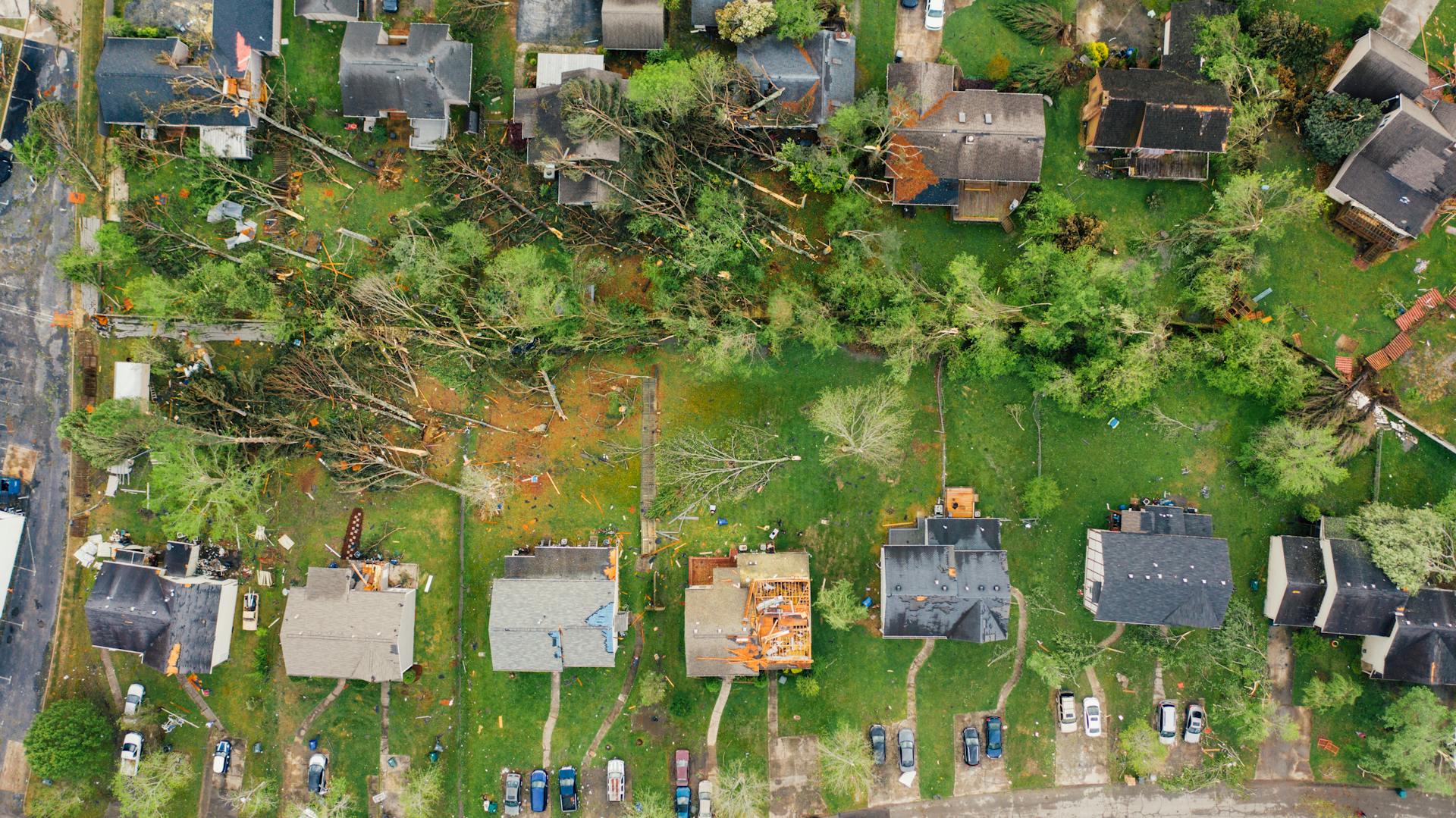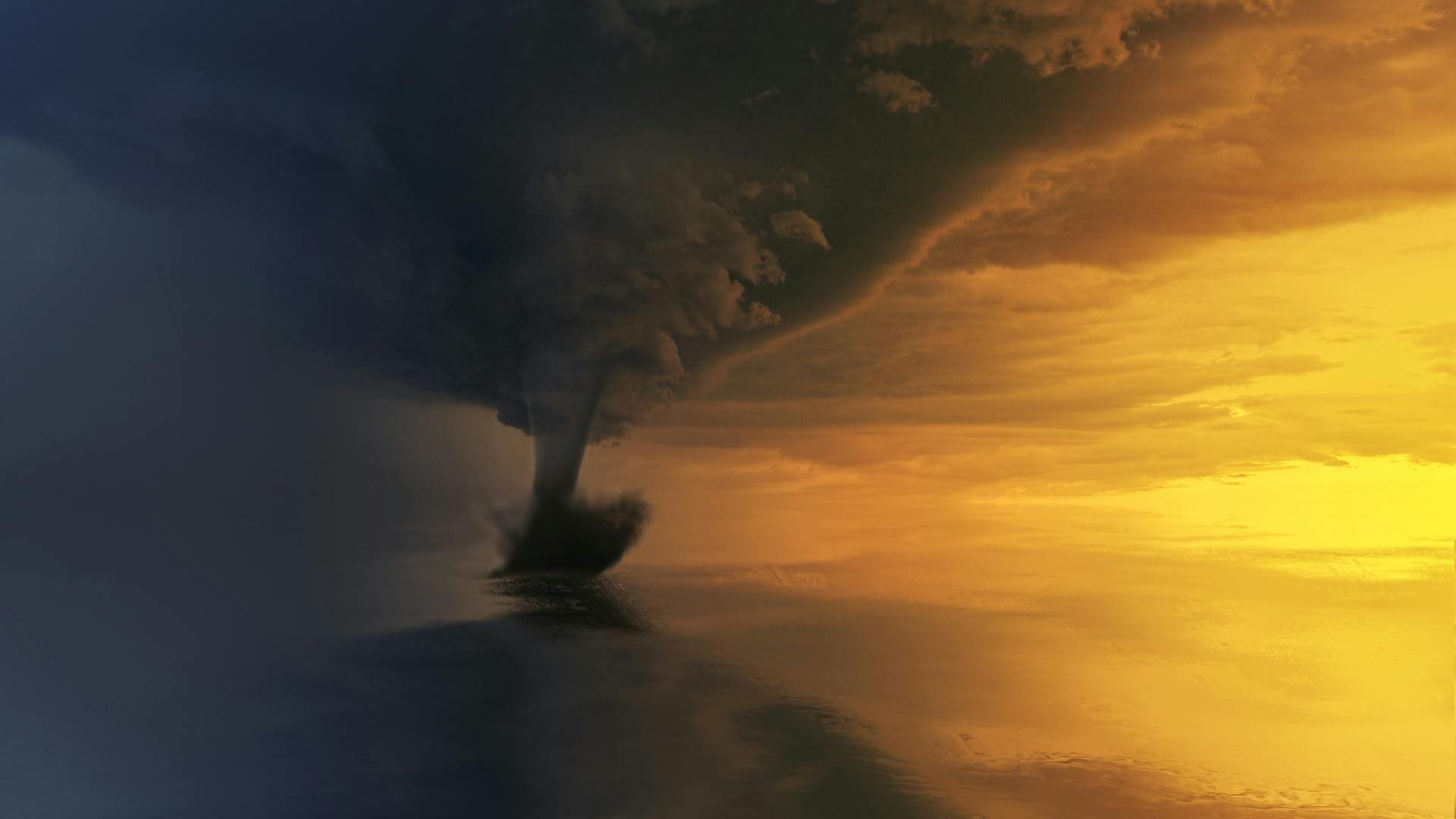
A tornado is a violently rotating column of air that is in contact with both the surface of the earth and a cumulonimbus cloud or, in rare cases, the base of a cumulus cloud. Tornadoes come in many shapes and sizes, but are typically in the form of a visible condensation funnel, whose narrow end touches the earth and whose wide end often extends into the cloud.
Most tornadoes have wind speeds less than 110 miles per hour (177 kilometers per hour), are about 250 feet (76 meters) across, and travel a few miles before dissipating. The most extreme tornadoes can have wind speeds of more than 200 miles per hour (322 kilometers per hour), be more than two miles (3.2 kilometers) across, and stay on the ground for dozens of miles.
Tornadoes are most often found in the so-called tornado alley, a region that includes parts of the central United States, typically Texas, Oklahoma, Kansas, Nebraska, Colorado, and South Dakota. They can also occur in other parts of the world, including Australia, Europe, Russia, and South America.
Tornadoes typically form when warm, moist air rises in updrafts beneath thunderstorms. As the air rises, it cools and the water vapor condenses, forming cumulonimbus clouds. If the conditions are just right, the updrafts can become so strong that they rotate. The rotation creates a vortex of air that extends from the cloud to the ground. The tornado is the visible manifestation of this vortex.
While tornadoes can occur at any time of year, they are most common in the spring and early summer in the United States. This is because that is when the jet stream shifts northward, bringing warm, moist air from the Gulf of Mexico into the Midwest.
Tornadoes are notoriously difficult to predict, which makes them particularly dangerous. They can occur without warning and strike with little time to take shelter. That said, there are some signs that a tornado may be forming, including a rotating wall cloud or a large, dark, low-lying cloud. If you see either of these, it is important to take cover immediately.
If you are in a building, go to the lowest level and get into a small, interior room, such as a closet or bathroom. If you are outdoors, seek shelter in a low-lying area, such as a ditch.
Consider reading: Tornadoes Happen
What causes a tornado?
Most tornadoes in the United States occur in the Great Plains, particularly in an area from the Rocky Mountains to the Appalachian Mountains known as Tornado Alley. Various thunderstorms can develop along this corridor, and if the right conditions occur, they can combine to create a tornado. But what, exactly, are the right conditions?
At the most basic level, a tornado is created when warm, moist air rises into the atmosphere and cooler, drier air rushes in to replace it. This temperature difference sets up a rotating column of air, which if strong enough can turn into a tornado.
There are several other factors that can contribute to the formation of a tornado. One is wind shear, which is a difference in wind speed or direction over a short distance. Wind shear can cause the rotating column of air to tipped over, forming a tornado.
Another factor is the presence of a mesocyclone. A mesocyclone is a large-scale, rotating area of thunderstorms. tornadoes often form within mesocyclones.
Finally, a a tornado can form if there is a large difference in atmospheric pressure between two areas. This difference in pressure can cause the rotating column of air to be drawn up into the atmosphere, where it can form a tornado.
While these are the most common factors that lead to the formation of a tornado, there are other less common factors that can also play a role. For example, a volcanic eruption can inject large amounts of dust and debris into the atmosphere, which can act as a catalyst for tornado formation.
In the end, the precise combination of conditions that leads to a tornado can vary depending on the location and time of year. But understanding the basics of how a tornado is created can help us to be better prepared when one does form.
A unique perspective: Scientist Study Tornadoes
What are the different types of air masses?
There are four main types of air masses that are commonly classified according to their temperature and moisture content. These are polar air masses, tropical air masses, continental air masses, and maritime air masses.
Polar air masses form over the Earth's polar regions and are characterized by being very cold and dry. The air in polar regions is generally very stable, meaning that these air masses tend to move very slowly.
Tropical air masses form over tropical regions, near the Earth's equator. These air masses are characterized by being warm and moist. The air in tropical regions is generally less stable than in other parts of the world, meaning that tropical air masses can move quickly and cause severe weather.
Continental air masses form over the continents, away from the oceans. These air masses are characterized by being either cold and dry or warm and moist, depending on the season. The air in continental regions is generally less stable than in other parts of the world, meaning that continental air masses can move quickly and cause severe weather.
Maritime air masses form over the oceans, near the Earth's coasts. These air masses are characterized by being moist and relatively cool. The air in maritime regions is generally more stable than in other parts of the world, meaning that maritime air masses tend to move slowly.
How do air masses interact to form a tornado?
As thunderstorms develop, they create an updraft. This updraft lifts warm, moist air from the surface. The warm air rises and the colder air pushes in to take its place. This movement of air creates a rotating column of air. If the column of air rotates fast enough, it can form a tornado.
Tornadoes are most likely to form when two different air masses meet. Warm, moist air from the Gulf of Mexico meets cold, dry air from the Rocky Mountains. This meeting of two different air masses creates instability in the atmosphere. The warm, moist air rises and the cold, dry air pushes in to take its place. This movement of air creates a rotating column of air. If the column of air rotates fast enough, it can form a tornado.
Tornadoes can be caused by other weather conditions as well. If there is a lot of instability in the atmosphere, but not enough wind shear, then thunderstorms may develop, but they will not form into tornadoes. Tornadoes need both instability and wind shear in order to form.
Expand your knowledge: Does House Insurance Cover Tornadoes
What is the difference between a dryline and a wetline?
A dryline is a boundary between two air masses, typically between warm and humid air to the east and cooler, drier air to the west. A wetline is a boundary between two air masses, typically between warm and moist air to the east and cooler, more moist air to the west. The terms are often used interchangeably, but there are subtle differences.
A dryline is typically associated with fair weather, while a wetline is often associated with unsettled weather. A dryline is often used to mark the dividing line between warm, humid air near the Gulf of Mexico and cooler, drier air from the West. A wetline is often used to mark the boundary between warm, moist air near the Gulf of Mexico and cooler, more moist air from the east.
The difference between a dryline and a wetline can be seen in the way they are drawn on a weather map. A dryline is typically drawn as a line with dashes, while a wetline is typically drawn as a line with squiggles. The term "dryline" is also used more generally to refer to any boundary between two air masses, regardless of whether it is associated with fair weather or not.
How does a tornado develop?
A tornado is a rotating column of air that extends from the base of a cumulonimbus cloud to the ground. Tornadoes are most often produced by severe thunderstorms. They occur when warm, moist air from the Gulf of Mexico collides with cold, dry air from Canada. This clash of air masses creates instability in the atmosphere, which causes the air to rise. As the air rises, it begins to rotate and form a vortex. The rotation of the earth causes the vortex to rotate even faster, and as the vortex of air grows, it extends from the cloud to the ground.
The wind speed in a mature tornado can exceed 300 mph, and the intense pressure inside the vortex can cause houses and other objects to be lifted into the air and carried for miles. Tornadoes can cause extensive damage to property and, in some cases, can cause fatalities.
Consider reading: Ground Tornado Shelters Safe
What is the difference between a supercell and a nonsupercell thunderstorm?
A thunderstorm is a type of storm that is typically associated with the entrapment of warm air within a colder air mass. This creates instability in the atmosphere and often results in precipitation. A supercell thunderstorm is a thunderstorm that is characterized by the presence of a mesocyclone, which is a large, rotating updraft. This updraft is usually much larger and more intense than those found in nonsupercell thunderstorms. As a result, supercell thunderstorms are often much more severe, and can produce large hail, strong winds, and tornadoes.
How can you predict when a tornado will occur?
A tornado is a rotating column of air that extends from a thunderstorm to the ground. Tornadoes can occur at any time of the year, but they are most common in the spring and summer months in the United States. They typically occur in the late afternoon or early evening.
There are a number of ways to predict when a tornado will occur. One is to look for signs of an approaching thunderstorm, such as darkening skies, large hail, or a rotating wall cloud. Another is to listen for a continuous roar, like a freight train, which indicates that a tornado is near.
If a tornado is approaching, take shelter immediately in a sturdy building. If you are in a vehicle, get out and find a low-lying area, such as a ditch, to protect yourself. If no shelter is available, lie flat on the ground and cover your head with your hands.
Most tornadoes in the United States occur in the Midwest, specifically in what is known as Tornado Alley, which includes parts of Texas, Oklahoma, Kansas, Nebraska, Iowa, and South Dakota. But tornadoes can occur anywhere in the country.
Tornado season in the United States typically runs from May through August, with the peak months being June and July. However, tornadoes have been known to occur as early as March and as late as November.
While predicting the exact time and location of a tornado is difficult, there are a number of resources available that can help you be prepared for one. The National Weather Service issues tornado watches and warnings, and provides updates on tornado activity through their website, social media, and mobile app. Local news stations also provide updates on tornado activity and may provide live coverage of a tornado as it happens.
When a tornado is occurring, it is important to take shelter immediately and stay tuned to your local news station or the National Weather Service for updates. By being prepared and knowing what to do, you can help keep yourself and your loved ones safe in the event of a tornado.
Frequently Asked Questions
How are tornadoes formed?
Typically, thunderstorms start to form when warm, moist air rises. This pressure releases energy as temperature differences cause the air to rise. The wind can help to establish a circulation. In the process of forming, strong winds rotate around an area of low pressure and heat up. When the winds reach a certain speed, they can create tornadoes.
Why are tornadoes more common in the spring?
The tornado frequency is related to the sun. The closer to the vernal (spring) equinox, or March 20th, the more tornadoes there will be because that is when the sun is at its highest in the sky.
What causes a tornado to form?
A tornado can form in a thunderstorm where the rotating air of an updraft (shown in purple) meets the rotating air of a downdraft (shown in aqua), which has turned upward.
How long does it take a tornado to form?
There is no one answer to this question because it can vary depending on a variety of factors, such as how much warm, moist air is available and the size and shape of the ground surface. However, typically it takes about 10 minutes for a tornado to form.
What makes a tornado visible?
The tornado is often visible because of the presence of a condensation funnel - a funnel-shaped cloud which forms due to the much-reduced pressure within the tornado vortex. Dust and other debris lofted by the intense winds can also help to make the tornado visible.
Sources
- https://www.youtube.com/watch
- https://www.answers.com/earth-science/How_do_air_masses_interact_to_form_a_tornado
- https://eartheclipse.com/environment/natural-disaster/what-is-a-tornado-and-what-causes-a-tornado.html
- https://brainly.sbs/geography/question20063977
- https://weatherology.com/trending/articles/Professor-Paul-Dry-Line.html
- https://www.answers.com/earth-science/How_do_air_masses_interact_to_form_a_hurricane
- https://people.uwec.edu/jolhm/eh/barnier/tornado.htm
- https://glossary.ametsoc.org/wiki/Dryline
- https://www.hurricaneschool.com/how-do-air-masses-interact-to-form-a-hurricane/
- https://knowledgeburrow.com/what-are-the-different-types-of-air-masses-what-are-the-characteristics-of-each/
- https://www.msn.com/en-us/weather/topstories/explained-what-causes-a-tornado/ar-AA12lKkC
- https://www.dw.com/en/what-causes-a-tornado/a-60116175
- https://www.foxweather.com/learn/dryline-severe-weather-forecasting
- https://www.examveda.com/the-motion-of-air-mass-in-a-tornado-is-a-51712/
- https://www.worldatlas.com/articles/what-is-a-tornado.html
Featured Images: pexels.com


